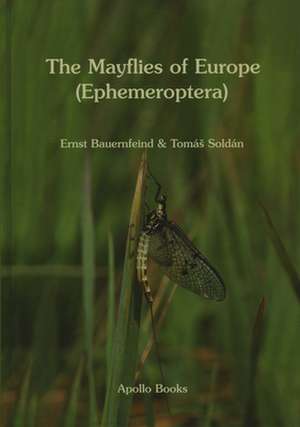The Mayflies of Europe (Ephemeroptera)
Autor Ernst Bauernfeind, Tomas Soldanen Limba Engleză Hardback – 28 feb 2012
The present handbook is designed to provide for the first time an up-to-date standard work for Ephemeroptera identification, including last instar larvae (nymphs), subimago (dun), male and female imagines. Recent changes in nomenclature are discussed in detail as well as gaps in current knowledge and probable pitfalls concerning the reliable identification of all taxa known so far from the region. Keys are provided for genera and introductory chapters characterize every family and genus.
Species accounts follow a common format providing a synonymy, characters for identification (including literature references), remarks (on type material, variation, confusing or extralimital species) and short information on biology and distribution pattern. Male genitalia are illustrated by micrographs and line drawings, REM photographs of the egg chorionic structure are provided for genera and selected species. Habitus of larvae and imagines are for most genera illustrated by colour photographs. The geographical area covered is Europe including the European part of Russia, the mediterranean islands and North Africa. Short additional information is provided for adjacent parts of the western Palaearctic Region.
A comprehensive index, check-list and distribution catalogue (following the widely adopted concept of Illies' Limnofauna Europaean) allow for quick information on all species recorded so far from Europe.
Preț: 918.12 lei
Preț vechi: 1119.66 lei
-18% Nou
175.76€ • 180.86$ • 148.16£
Carte indisponibilă temporar
Specificații
ISBN-10: 8788757455
Pagini: 783
Dimensiuni: 178 x 244 x 43 mm
Greutate: 1.97 kg
Editura: Brill
Colecția Brill
Cuprins
Abstract
Introduction
Key to the European genera (larvae)
Key to the European genera (imagines)
Check-list
Systematic treatment (family, genus, species)
Distribution catalogue
Colour plates
Illustrations of male genitalia
Illustrations of eggs
References
Index
Recenzii
PETER C. BARNARD, Gillingham, Dorset, U.K., in:Entomologist’s Monthly Magazine, September-December 2012, p.205
This is an important book on mayflies and a ‘must have’ for anyone interested in … Ephemeroptera.
JOHN BADMIN,Br. J. Ent. Nat. hist.26 (2013) pp. 124-125
Descriere
Among the various groups of aquatic insects, mayflies (Ephemeroptera) are of special interest for professional limnologists and entomological researchers as well as for naturalists in general and even the dedicated fly angler. Identification has traditionally been considered difficult and implementation in environmental monitoring and freshwater management has led to an ever increasing demand for exact information on taxonomy and ecology.
The present handbook is designed to provide for the first time an up-to-date standard work for Ephemeroptera identification, including last instar larvae (nymphs), subimago (dun), male and female imagines. Recent changes in nomenclature are discussed in detail as well as gaps in current knowledge and probable pitfalls concerning the reliable identification of all taxa known so far from the region. Keys are provided for genera and introductory chapters characterize every family and genus.
Species accounts follow a common format providing a synonymy, characters for identification (including literature references), remarks (on type material, variation, confusing or extralimital species) and short information on biology and distribution pattern. Male genitalia are illustrated by micrographs and line drawings, REM photographs of the egg chorionic structure are provided for genera and selected species. Habitus of larvae and imagines are for most genera illustrated by colour photographs. The geographical area covered is Europe including the European part of Russia, the mediterranean islands and North Africa. Short additional information is provided for adjacent parts of the western Palaearctic Region.
A comprehensive index, check-list and distribution catalogue (following the widely adopted concept of Illies’ Limnofauna Europaean) allow for quick information on all species recorded so far from Europe.
